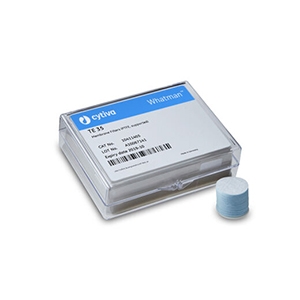Our large inventory ensures that you can find the exact type of PTFE membrane filters you need without the hassle of browsing multiple distributor websites.
-
-

-
- SECO Part No: GEH-7592-104
- Sold As:
-
Availability:

PM2.5 Air Monitoring Membrane Filter, 2 µm Pore Si...
PM2.5 Air Monitoring Membrane Filter, 2 µm Pore Size, 46.2 mm dia, Polytetrafluoroethylene (PTFE), Circle, 99.7% Particle Retention, 25 µeq/g of filter Maximum Alkalinity, Polypropylene Support Ring, Sequentially Numbered FiltersPM2.5 Air Monitoring Membrane Filter, 2 µm Po More...
-
Login to View Your Price
List Price :
-
Add to cart
-
-
-

-
- SECO Part No: IWT-IWT-ES10500
- Sold As:
-
Availability:

SECO PTFE Inline Membrane Filter, 50 mm dia, 0.22 ...
Membrane Filter, 50 mm dia, 0.22 µm Pore Size, Inline, PTFE, Polypropylene, Ultrasonically Welded, 0.25 to 0.37" Barb Ports, 0.01 to 0.3" Thickness, Hydrophobic, -450 to 500°F Temperature Range, SterileMembrane Filter, 50 mm dia, 0.22 µm Por More...
-
Login to View Your Price
List Price :
-
Add to cart
-
-
-

-
- SECO Part No: GEH-10411311
- Sold As:
-
Availability:

Membrane Filter, 0.45 µm Pore Size, 47 mm dia, Pol...
Membrane Filter, 0.45 µm Pore Size, 47 mm dia, Polytetrafluoroethylene (PTFE), Circle, TE 36 Range Membrane Type, Hydrophobic, 12 sec/100 ml/12.5 cm2 Flow Rate, 100°C Maximum Operating Temperature, For Aggressive Organic Solvents, Strong Acids and AlkalisMembrane Filter, 0.45 µm Pore Size, 47 mm dia More...
-
Login to View Your Price
List Price :
-
Add to cart
-
-
-

-
- SECO Part No: 12-4536-08
- Sold As:
-
Availability:

Membrane Filter, 0.5 µm Pore Size, 47 mm dia, Poly...
Membrane Filter, 0.5 µm Pore Size, 47 mm dia, Polytetrafluoroethylene (PTFE), Circle, WTP Range Membrane Type, Hydrophobic, 72% Maximum Porosity, 110 ml/min/cm2 Liquid Flow Rate at 10 psi Vacuum, 120°C Maximum Operating TemperatureMembrane Filter, 0.5 µm Pore Size, 47 mm dia, More...
-
Login to View Your Price
List Price :
-
Add to cart
-
-
-

-
- SECO Part No: 10-4114-11
- Sold As:
-
Availability:

Membrane Filter, 0.2 µm Pore Size, 47 mm dia, Poly...
Membrane Filter, 0.2 µm Pore Size, 47 mm dia, Polytetrafluoroethylene (PTFE), Circle, TE 35 Range Membrane Type, Hydrophobic, 24 sec/100 ml/12.5 cm2 Flow Rate, 100°C Maximum Operating Temperature, For Aggressive Organic Solvents, Strong Acids and AlkalisMembrane Filter, 0.2 µm Pore Size, 47 mm dia, More...
-
Login to View Your Price
List Price :
-
Add to cart
-
-
-

-
- SECO Part No: GEH-10411211
- Sold As:
-
Availability:

Membrane Filter, 1 µm Pore Size, 47 mm dia, Polyte...
Membrane Filter, 1 µm Pore Size, 47 mm dia, Polytetrafluoroethylene (PTFE), Circle, TE 37 Range Membrane Type, Hydrophobic, 5.4 sec/100 ml/12.5 cm2 Flow Rate, 100°C Maximum Operating Temperature, For Aggressive Organic Solvents, Strong Acids and AlkalisMembrane Filter, 1 µm Pore Size, 47 mm dia, P More...
-
Login to View Your Price
List Price :
-
Add to cart
-
-
-

-
- SECO Part No: 12-4536-01
- Sold As:
-
Availability:

Membrane Filter, 0.2 µm Pore Size, 25 mm dia, Poly...
Membrane Filter, 0.2 µm Pore Size, 25 mm dia, Polytetrafluoroethylene (PTFE), Circle, WTP Range Membrane Type, Hydrophobic, 72% Maximum Porosity, 61.4 ml/min/cm2 Liquid Flow Rate at 10 psi Vacuum, 120°C Maximum Operating TemperatureMembrane Filter, 0.2 µm Pore Size, 25 mm dia, More...
-
Login to View Your Price
List Price :
-
Add to cart
-
-
-

-
- SECO Part No: GEH-10411111
- Sold As:
-
Availability:

Membrane Filter, 5 µm Pore Size, 47 mm dia, Polyte...
Membrane Filter, 5 µm Pore Size, 47 mm dia, Polytetrafluoroethylene (PTFE), Circle, TE 38 Range Membrane Type, Hydrophobic, 2.2 sec/100 ml/12.5 cm2 Flow Rate, 100°C Maximum Operating Temperature, For Aggressive Organic Solvents, Strong Acids and AlkalisMembrane Filter, 5 µm Pore Size, 47 mm dia, P More...
-
Login to View Your Price
List Price :
-
Add to cart
-
-
-

-
- SECO Part No: GEH-10411205
- Sold As:
-
Availability:

Membrane Filter, 1 µm Pore Size, 25 mm dia, Polyte...
Membrane Filter, 1 µm Pore Size, 25 mm dia, Polytetrafluoroethylene (PTFE), Circle, TE 37 Range Membrane Type, Hydrophobic, 5.4 sec/100 ml/12.5 cm2 Flow Rate, 100°C Maximum Operating Temperature, For Aggressive Organic Solvents, Strong Acids and AlkalisMembrane Filter, 1 µm Pore Size, 25 mm dia, P More...
-
Login to View Your Price
List Price :
-
Add to cart
-
-
-

-
- SECO Part No: GEH-10411313
- Sold As:
-
Availability:

Membrane Filter, 0.45 µm Pore Size, 50 mm dia, Pol...
Membrane Filter, 0.45 µm Pore Size, 50 mm dia, Polytetrafluoroethylene (PTFE), Circle, TE 36 Range Membrane Type, Hydrophobic, 12 sec/100 ml/12.5 cm2 Flow Rate, 100°C Maximum Operating Temperature, For Aggressive Organic Solvents, Strong Acids and AlkalisMembrane Filter, 0.45 µm Pore Size, 50 mm dia More...
-
Login to View Your Price
List Price :
-
Add to cart
-
-
-

-
- SECO Part No: GEH-10411405
- Sold As:
-
Availability:

Membrane Filter, 0.2 µm Pore Size, 25 mm dia, Poly...
Membrane Filter, 0.2 µm Pore Size, 25 mm dia, Polytetrafluoroethylene (PTFE), Circle, TE 35 Range Membrane Type, Hydrophobic, 24 sec/100 ml/12.5 cm2 Flow Rate, 100°C Maximum Operating Temperature, For Aggressive Organic Solvents, Strong Acids and AlkalisMembrane Filter, 0.2 µm Pore Size, 25 mm dia, More...
-
Login to View Your Price
List Price :
-
Add to cart
-
-
-

-
- SECO Part No: GEH-10411113
- Sold As:
-
Availability:

Membrane Filter, 5 µm Pore Size, 50 mm dia, Polyte...
Membrane Filter, 5 µm Pore Size, 50 mm dia, Polytetrafluoroethylene (PTFE), Circle, TE 38 Range Membrane Type, Hydrophobic, 2.2 sec/100 ml/12.5 cm2 Flow Rate, 100°C Maximum Operating Temperature, For Aggressive Organic Solvents, Strong Acids and AlkalisMembrane Filter, 5 µm Pore Size, 50 mm dia, P More...
-
Login to View Your Price
List Price :
-
Add to cart
-








